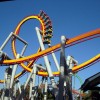Weird Magnet Fact of the Week: Magnets are Brakes on Amusement Rides
Magnets don’t just go on your fridge. In fact, magnets are in many technical, real-world applications. For example, magnets are used in amusement parks all over the world and in roller coasters as braking mechanisms. The neat part about magnetic brakes is that magnets do not require electrical power and if the power stops, the brakes won’t be affected.
Here’s How It Works
Modern roller coasters most likely use permanent magnets as brakes. Permanent magnets do not require an energy source and are powered by the magnetism in nature, unlike electromagnets. Because of this, the brakes even operate in power outages, which is good news for your friends with a rollercoaster fear.
Roller coasters will usually have a magnetic, metallic fin below them. The magnet and the metallic fin will both have magnetic fields that cause each other to push in opposite directions, slowing roller coaster down. Although magnetic brakes are smoother and do not require an energy source. Typically, the brakes are coupled with other powered brake systems.Magnetic Propulsion
On the flipside, magnets can be used to propel as well as decelerate. Unlike the permanent magnets commonly used to stop roller coasters, electromagnets are used in the propulsion of roller coasters. Electromagnets require a force of energy to power them.
To learn more about how magnets serve as brakes and to see a demonstration of them in action, check out this National Geographic video.
